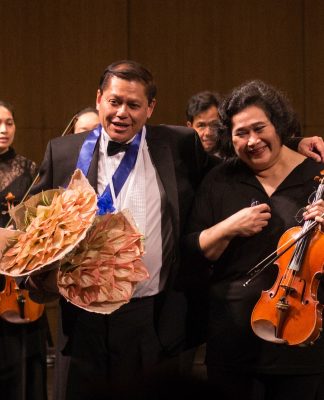 IS THIS the face of Christ?
IS THIS the face of Christ?
This question has intrigued the millions of poeple who have seen the Shroud of Turin, the venerated “burial clothes of Jesus Christ” believed to have captured Christ’s image after the Crucifixion.
According to Maricar Estrabo, project officer of “The Mystery of the Shroud of Turin: The Philippine Exhibition” and a member of the Crusaders of the Holy Face, the Shroud of Turin, despite doubts about its authenticity, is one of the most precious treasures of Christianity.
“Although the Shroud of Turin is not known to many, the value given to it is manifested through its expositions,” Estrabo told the Varsitarian. “The Shroud of Turin is viewed by the public three to four times only in a century. Today, it is safely kept in a special chamber designed to preserve the artifact in Turin, Italy.”
Shrouded credibility
As early as 1357, the Shroud has been the subject of scrutiny, with scholars questioning its authenticity. Henri de Poitiers, bishop of Troyes in France, considered the Shroud a painted forgery and prohibited its public display. The linen cloth still survived even in the face of outright skepticism.
It was only in 1898 when the Church allowed the Shroud of Turin to be photographed for scientific examination. At the bidding of Pope Pius XI, Paul Joseph Vignon, a French biologist, facilitated the test. This paved the way for historical and scientific studies on the “relic.”
Among the theories seeking to disprove the authenticity of the Shroud are the Leonardo Da Vinci Theory, the Templar Theory, the Photography Theory, and the Shadow Shroud Theory.
The Leonardo the Vinci Theory was published by Lynn Picknett and Clive Prince in their book Turin Shroud: In Whose Image? (Harper-Collins, 1994). According to them, Da Vinci forged the image on the Shroud in the late 1400s.
Meanwhile, the Templar Theory of Christopher Knight and Robert Lomas considers the shroud’s image to be that of Jacques de Molay, the tormented Grand Master of the Knights Templar, and not Jesus Christ’s.
The Photography Theory of Nicholas Allen of the University of Durbon-Westville in South Africa proposes that the image is a photograph produced in the 14th century. Allen argues that the Shroud is a photographic plate, intentionally printed with a man’s image.
Lastly, the Shadow Shroud Theory was proposed by Nate Wilson, associate professor of Microbiology at the University of Idaho. Based on his tests on the artifact, Wilson said the image on the Shroud was the result of the light exposure of an oil painting on a glass, which was then imposed upon the fabric.
Contrary to these assertions are the Middle East Pollen Theory and the Risen Christ Theory.
The Middle East Pollen Theory states that the Shroud had stayed longest in the Middle East, based on a study by Max Frei, a Swiss criminologist. Frei found that pollen grains which have remained on the Shroud for centuries are native to Jerusalem.
Meanwhile, the Risen Christ Theory concludes that the image on the Shroud was the effect of the intense light from the body of Christ upon Resurrection.
In addition, hemoglobin (a component of blood) found on the stains of the Shroud by forensic experts John Heller and Allan Adler has kept the possibility that the Shroud had indeed covered Christ after his death.
In October 1988, Anastacio Cardinal Ballestrero, Archbishop of Turin, released the results of the carbon-14 dating (a test that estimates the age of antique materials) of the Shroud of Turin, which indicated that the artifact’s age ranged from 598 to 728 years. The findings implied that the Shroud was made several years after the death of Jesus Christ. However, this was negated by the findings of Leoncio Garza-Valdes of the University of Texas and his colleagues. According to them, bacteria and fungi on the Shroud could have altered the results of carbon-dating.
Despite numerous claims against the relic’s authenticity, the late Pope John Paul II, in his address to the 1998 Shroud Exposition, acknowledged the significance of the Shroud to the Christian faith.
“For the believer, what counts above all is that the Shroud is a mirror of the Gospel,” the late Pope said. “The Shroud is also an image of God’s love as well as of human sin and suffering.”
Shroud visits the Philippines
“The Mystery of the Shroud of Turin: The Philippine Exhibition,” which features a replica of the Shroud, aims to introduce the artifact to Filipinos.
“The Catholic Church accepts the veneration given to the Shroud of Turin even though the Church has no official stand regarding its authenticity,” Estrabo told the Varsitarian. “In this exhibit, we will present both the scientific and historical aspects of the Shroud of Turin.”
Aside from life-sized dioramas portraying the suffering Christ, various documentaries are shown to guide the audience in demystifying the Shroud of Turin. Afterwards, a photo gallery featuring enlarged portions of the Shroud awaits visitors.
There’s a small chapel at the end of the exhibit for reflection.
The Shroud of Turin Exhibit runs at the SM Mall of Asia until Dec. 9. This project is for the benefit of the Sisters of the Holy Face Congregation, the Holy One of the Lord Catholic Foundation, and the Diocese of Parañaque.
Today, the Sisters of the Holy Face Congregation in the Philippines and its lay arm, the Crusaders of the Holy Face, have the Shroud of Turin as its main object of veneration.















